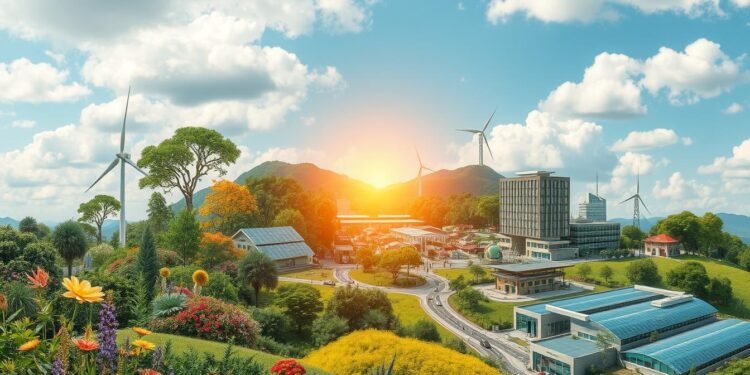Sustainability is a big topic, with over 2 billion Google searches. The Three E’s of Sustainability framework is a simple way to understand it. It has three main parts: taking care of the environment, making sure the economy works well, and ensuring fairness for everyone.
The U.S. Environmental Protection Agency says we need the natural world to survive. This idea was in the National Environmental Policy Act of 1969. Now, the Three E’s help us live in a way that doesn’t harm the future.
The Three E’s affect our daily lives. For example, using wind and solar power is now the cheapest way to make energy. This shows we can be good to the environment and save money. Fair Trade certifications also help make sure everyone is treated fairly, showing we care about social equity.
Key Takeaways
- The Three E’s of Sustainability are Environment, Economy, and Social Equity
- Environmental sustainability involves local and global impact assessment
- Economic sustainability includes profit stability and business resilience
- Social equity ensures equal benefits and opportunities for all
- Balancing all three E’s is key for true sustainability
- Sustainable practices are becoming more important in many fields
Understanding the Three E’s of Sustainability
Sustainability is a big deal in our world today. It’s based on three main pillars: environmental, economic, and social equity. These pillars help us grow and develop in a balanced way.
Definition of Each “E”
Environmental sustainability is about protecting our planet. It means reducing pollution, saving energy, and keeping biodiversity alive. Economic sustainability is about financial stability without harming nature. It supports sustainable businesses and fair trade.
Social equity makes sure everyone has equal chances and resources. It doesn’t matter where you come from or what you have.
History and Development
The idea of sustainability started in 1987 with the Brundtland Report. This UN document said we should meet today’s needs without hurting tomorrow’s. Ever after, many efforts have helped us understand sustainability better.
The Earth Charter in 2000 talked about ethics for a sustainable future. In 2015, the UN set 17 Sustainable Development Goals. These goals balance economic, social, and environmental needs. These steps have shaped our view of the Three E’s and their role in a sustainable world.
The Importance of Environmental Sustainability
Environmental sustainability is key to saving our planet for the future. It aims to balance human actions with nature’s ability to heal. This idea is more than just protecting nature; it’s about using resources well to keep life on Earth going.
Benefits for the Planet
Using eco-friendly ways helps our world a lot. By cutting down our carbon footprint, we fight climate change. This means fewer big weather disasters like floods and droughts.
Sustainable actions also help keep different species alive, protect nature, and make air and water cleaner.
Strategies for Implementation
Working together is essential for environmental sustainability. A big step is moving to clean energy like solar and wind. Companies using solar panels can cut their electricity costs by up to 70%.
People can help by supporting green farming, growing their own food, and buying local to cut down on emissions from transport.
Businesses are also important in making our planet greener. Most people in the US and Europe want to buy from companies that care about the environment. This is true for job seekers too, with 71% looking for jobs in green companies. By going green, businesses can win customers and the best employees while helping the planet.
Economic Sustainability Explained
Economic sustainability is key in the circular economy. It aims to use resources well to keep profits up and growth going. This way, businesses can do well without hurting future generations.
Key Principles
The heart of economic sustainability is finding a balance between making money and doing good. Companies try to cut down on waste and use resources better. For example, Walmart has reduced packaging waste in its supply chain.
Such efforts not only save costs but also encourage new ideas and strength.
Real-World Applications
Sustainable investments are vital in economic sustainability. From 2020 to 2022, U.S. sustainable investments fell from $17.1 trillion to $8.4 trillion. Yet, 349 money managers and 1,359 community investment groups use ESG criteria in their choices.
This shows more people see the value of green practices in business.
Companies are making sustainability a big part of their plans. They focus on people, planet, and profit. This method helps bring together different efforts, meets ESG standards, and wins public support.
By balancing these, businesses can truly be sustainable and help the circular economy.
Social Sustainability: The People Factor
Social sustainability focuses on people at the center of development. It aims to build fair societies where everyone can succeed. This idea is essential for achieving the United Nations’ sustainable development goals.
Community Engagement
Creating strong communities is key to social sustainability. It means giving people a say in decisions that impact their lives. Cities and towns are now involving residents in planning.
They use online surveys, town halls, and citizen committees to hear from people. This approach helps build places that really meet people’s needs.
Health and Wellbeing
Social sustainability also emphasizes keeping people healthy and happy. It’s not just about medical care. It includes safe homes, good jobs, and clean environments.
Companies are now valuing worker wellbeing. They offer better benefits, flexible hours, and mental health support. Governments are investing in public spaces and programs that bring people together.
Social equity is at the heart of this effort. It ensures everyone has access to opportunities, no matter their background. This means fair hiring, affordable housing, and equal education chances. By supporting all members of society, we build stronger, more resilient communities for the future.
How the Three E’s Interconnect
The Three E’s of Sustainability – Economy, Ecology, and Equity – are key to healthy communities. They work together for a balanced approach to sustainable goals. Knowing how they connect is vital for a green economy.
Systemic Relationships
Research shows a strong link between the Three E’s. A study from 1990 to 2015 found economic inequality lowers renewable energy use. This shows how equity affects ecological choices.
The study also found more equality means more renewable energy use. This shows the complex links between these pillars.
Case Studies of Integration
Libraries are great examples of integrating the Three E’s. They help the economy by providing free resources. They also support the environment with programs and ensure everyone has access.
The average American pays just $20 a year in taxes for libraries. Yet, they get a lot of value. This shows how institutions can meet economic, ecological, and social needs.
The UN’s sustainable development goals follow this approach. They tackle social, economic, and environmental aspects together. This strategy sees progress as needing all Three E’s in balance.
Measuring Sustainability Success
It’s key to measure how well we’re doing in sustainability. This helps us see if we’re reaching our goals for a greener economy. Companies and governments use different tools to check their progress in the environment, society, and economy.
Key Performance Indicators (KPIs)
KPIs are important for checking how well we’re doing in sustainability. For example, we might look at how much carbon we’re cutting down or how much land we’re saving. We also check how many jobs we’re creating and how stable people’s incomes are.
Looking at social KPIs, we see how involved communities are and if people are getting fair pay. Studies show that if a country does better, its sustainability also improves.
Tools and Frameworks
The Triple Bottom Line framework is great for looking at sustainability in a complete way. The Sustainability Flywheel uses data to boost environmental efforts. The Sustainability Maturity Path model has three main areas: Motivation, Accountability, and Ownership.
Tools like these help companies set and reach their sustainability goals. Fair Trade certifications focus on fairness in work. The UN Commission on Sustainable Development looks at economic, environmental, and social aspects together.
By using these frameworks, businesses can make sure they’re following global sustainability standards. This helps us all work towards a greener future.
Challenges in Achieving Sustainability
The journey to sustainability is full of obstacles. Companies and governments find it hard to grow while being green. This struggle slows down reaching sustainable goals.
The desire for quick money often takes over environmental worries. This is a big problem.
Common Barriers
One major issue is the lack of support for green policies. Many countries don’t want to work together on these issues. This makes solving global problems like climate change very difficult.
Another problem is how complex sustainability is. It involves the environment, society, and economy. This makes creating effective plans very challenging.
Overcoming Obstacles
To overcome these challenges, we need new ideas. The Grey System Theory helps us understand complex systems with limited data. This leads to better choices for the environment, society, and economy.
We also need more teamwork. Companies, governments, and people must work together for a sustainable future. This includes reducing carbon emissions, fighting poverty, and protecting nature.
By facing these issues head-on, we can create a world that meets our needs without harming future generations.
Future Trends in Sustainability
Sustainability is changing fast, with new ideas coming up. The green economy is growing as more businesses and people choose eco-friendly options. This change is because of growing awareness of the environment and the need for green solutions.
Innovations and Breakthroughs
Renewable energy is leading the way in sustainability. Solar and wind power are getting better and cheaper. The idea of a circular economy is also becoming popular, aiming to use resources wisely and cut down on waste.
Companies are now making products that last longer and can be recycled. This helps reduce their harm to the environment.
Sustainable farming is another area seeing big changes. Vertical farming and precision agriculture are solving food problems while using less. The seafood industry is also improving, with better farming and fishing methods that don’t harm the oceans.
Role of Technology
Technology is key in making sustainability work. Smart sensors and AI help use resources better in many fields. They track how we affect the environment and help us be more sustainable.
In cities, tech is making them smarter and more energy-efficient. This improves life for everyone living there.
Blockchain technology is also helping the green economy. It tracks where products come from, making sure they’re made ethically and sustainably. This builds trust with consumers and encourages businesses to act responsibly.
The Role of Businesses in Sustainability
Businesses play a big role in making our world more sustainable. They shape our economy and affect society and the environment. Now, many companies focus on corporate social responsibility as a key part of their strategy.
Corporate Social Responsibility (CSR)
CSR means companies balance making money with doing good. A 2019 study showed that giving to charities can increase a company’s value. This shows that CSR can be good for business.
The UN-backed Principles for Responsible Investment saw a big increase in companies committed to sustainability from 2006 to 2018. This shows more companies are getting on board with sustainability.
Examples of Sustainable Practices
Many big companies are working on sustainable development goals. Walmart wants to be carbon-free by 2040. Google aims to be carbon-free by 2030. These goals show businesses can lead in making the environment better.
Using renewable energy and rethinking supply chains are just a few ways companies can be more sustainable. Sustainability is good for the planet and for business. Studies show most consumers care about sustainability when choosing brands.
Many job seekers also prefer working for companies that care about the environment. By adopting sustainable practices, companies can attract customers, talent, and investors. This helps create a better world for everyone.
Taking Action: How You Can Contribute
We all can help make the world more sustainable. By changing a few things in our daily lives, we can help reach the United Nations’ goals for 2030.
Individual Initiatives
Begin by reducing your carbon footprint. Eating less meat and dairy can lower your emissions by up to 500 kilograms a year. Choose plant-based foods, which need less energy, land, and water.
Instead of driving, walk, bike, or use public transport. Living without a car can cut your carbon footprint by up to 2 tons a year.
At home, focus on saving energy. Use LED lights, turn off electronics when not in use, and take shorter showers. Showers use about 9 liters of water per minute. These small steps make a big difference.
Community Programs
Get involved in local sustainability projects. Join community gardens, help with recycling, or teach others about eco-friendly practices. Support businesses that care about the planet and push for policies that support sustainable development.
Together, we can make a big difference. We can create a better future for everyone by working together.
FAQ
What are the Three E’s of Sustainability?
The Three E’s of Sustainability are Environment, Economy, and Social Equity. This framework guides us in living sustainably. It shows that true sustainability needs a balance of all three.
How did the concept of sustainability gain prominence?
Sustainability became well-known in 1987 with ‘Our Common Future’ by a UN commission. This report said we should meet today’s needs without harming future generations.
What does environmental sustainability focus on?
Environmental sustainability looks at how we affect nature, from local areas to global climate. It aims for a balance where our impact doesn’t harm the environment’s ability to heal.
How does economic sustainability apply to businesses and communities?
For communities, economic sustainability means affordable homes, jobs, and income stability. It also supports small businesses. For businesses, it’s about making money now and in the future, and being ready for surprises.
What is social sustainability?
Social sustainability ensures everyone gets a fair share of sustainability benefits. It means equal say in decisions and access to resources. In business, it means fair wages, ethical supply chains, and gender equality.
How are the Three E’s of Sustainability interconnected?
The Three E’s are connected and need balance for true sustainability. They’re like a three-legged stool, where each leg must be strong.
How can sustainability success be measured?
Measuring success in sustainability looks at all Three E’s. This includes environmental, economic, and social equity KPIs. Tools like the Triple Bottom Line help evaluate performance.
What are some challenges in achieving sustainability?
Challenges include balancing use with regeneration, tackling global issues like climate change, and keeping ethics in business. We also face systemic inequalities and ensuring fair benefits.
What are some future trends in sustainability?
Future trends include more renewable energy, circular economies, and tech for sustainability. Sustainable farming and fishing are also key for food security.
How can individuals contribute to sustainability?
Individuals can help by reducing carbon footprints, using eco-friendly products, and supporting green businesses. Reducing energy, recycling, and choosing public transport are also important. Getting involved in local sustainability efforts can make a big difference.





